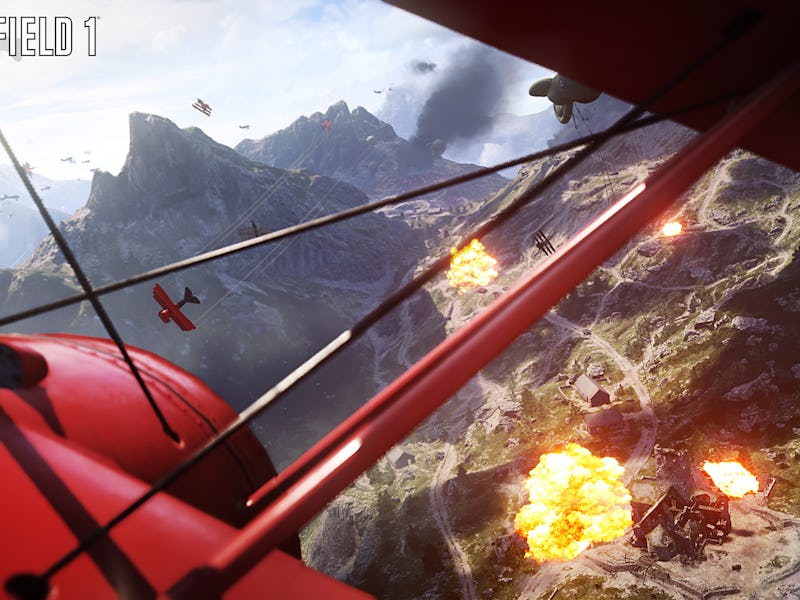The 'Battlefield 1' Open Beta Shows the Game is Off to a Promising Start
All minor glitches and server issues aside, DICE's take on WWI is looking great.

This week, the open beta for Battlefield 1 arrived on PC, Xbox One and PS4. This evolution of the Battlefield franchise ironically took a step backwards in time, diving into the conflict of World War I. But, this step back is a step forwards for the franchise as a whole.
On the surface, Battlefield 1 feels exactly like its predecessors. You have four separate classes that each bring a unique weapon class and toolkit to the field in order to perform a specific role.
This time around, the assault class are masters of close-quarter and anti-vehicle combat, with access to submachine guns, shotguns, AT weaponry and a few different grenade types. Once again, support is the ammo distributor on the field, with access to light machine guns and ammunition boxes, while the medical role now has a dedicated class with access to DMRs and revive equipment. Largely, each of these classes feels the same as before from a gameplay standpoint.
The one class that does feel different is the Scout. In Battlefield 1, scouts have what’s known as a lethal vector, meaning they’re very effective when situated at medium range from a target. When at close and long range, their effectiveness drops drastically – but as a result, I found myself consistently moving about the map in order to remain at my optimal range. While it certainly doesn’t fix the idea of snipers camping up on a specific mountain, is has an impact on the class for the better.
What’s more interesting is the introduction of separate vehicle classes in place of the Engineer class. Instead of having a dedicated class with a repair torch, Battlefield 1 spawns you into vehicles with a class specific to that vehicle. For planes, you’ll spawn in as a pilot, and for tanks you’ll spawn in as a tanker. Both tankers and pilots are limited to a low-damage carbine, sidearm and toolkit that allows them to repair their specific vehicle — which makes them strong within said vehicle, but extremely weak outside of it.
Pilots and tankers also have the ability to repair their vehicle while in flight too – restoring roughly 20 percent of their vehicles health with every successful repair. This does leave them open to attack however, as they cannot shoot or move without interrupting the repair. Essentially, Battlefield 1 seems to reward players for playing their vehicle this time around instead of punishing them for sticking with one in-particular through a match.
In the open beta these changes really do wonders for vehicle and infantry combat, preventing players from hopping in and out of vehicles as they see fit. Instead, you have players dedicating themselves to an infantry or vehicle support role, which helps alter the flow of combat between players on the ground and players in vehicles in a more believable way. Combine this with the new entering and exiting animations present for all the vehicles and you have a much better gameplay loop for players looking to enjoy vehicle combat, and infantry who want to worry about engaging fellow enemies on the ground.
During the open beta, we also got a taste of the new dynamic weather system in play on each of Battlefield 1’s maps. The idea behind the introduction of dynamic weather was simply to provide an altered battlefield for players that consistently changes each game, and while I’ll admit I did have my doubts, it’s hard not to appreciate the system in action.
On the map available in the open beta, Sinai Desert, the dynamic weather system can usher sandstorms down across the entire map. Each of these has a different level of severity, meaning you’ll experience everything from smaller storms that slightly reduce long-range visibility, to heavy sandstorms that can prevent you from seeing 5 feet in front of you. But, the best part is they happen randomly for a random amount of time, which means you’ll never know when to expect them during a match.
I found these sandstorms to be both my enemy and my ally depending on what I was trying to accomplish on the battlefield. For the few games where I was flying planes, they frustrated me because they hindered my effectiveness, but for the few games I was playing on the ground, I couldn’t get enough of them because they helped me push an objective. It’s a compelling system that helps maps feel more dynamic.
It’s important to note the Battlefield 1 open beta does experience some performance issues on both Xbox One and PS4, namely during the sandstorms and when multiple vehicles are laying around you destroyed. The frame rate drops on PS4 weren’t enough to ruin my experience – but a few times it was upsetting to see the engine chug during an intense combat scenario.
Regardless, the Battlefield 1 open beta does show some significant improvements on the Battlefield formula that were much needed. The removal of lock-on weaponry, introduction of dynamic weapon systems and vehicle changes all feel well thought out and implemented in the build we’re currently playing. That said, there are a few things, such as dynamic weather, I’m curious about seeing in the full game – while Sinai Desert may do a great job at generating weather patterns that feel good from a gameplay perspective, that may not apply to the rest of the maps on launch day.
For now, Battlefield 1 feels good and has us excited to dive into World War I this October.